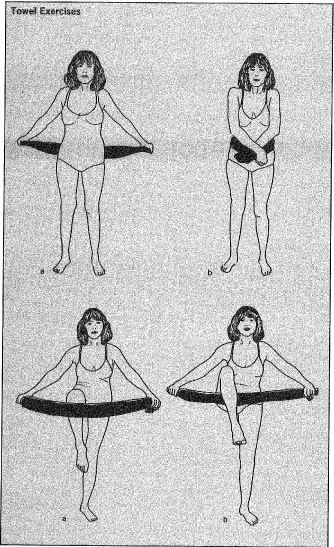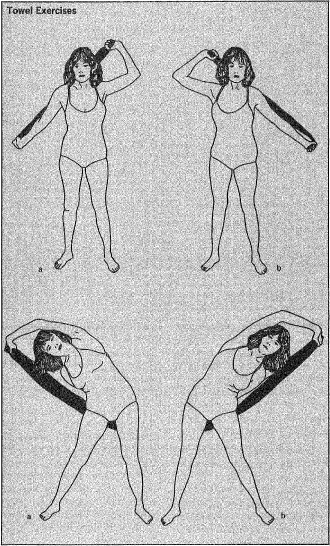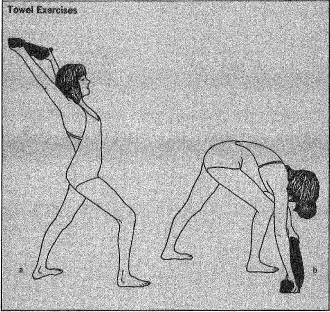Starting With Some Easy Exercises - Sitting, towel, and other exercise routines
As emphasized earlier, a basic exercise program can include a variety of supplementary movements and exercises that add zest. Additional exercises can also be practiced separately from regular exercise sessions and under the most informal of circumstances: when taking a shower, toweling off after the shower, sweeping the floor with a broom, and in other situations. Any of these can be programmed into the basic fitness schedule without difficulty.
Sitting-down Exercises
With no more special equipment than a sturdy, dependable chair, you can do at least ten different exercises. For some of the exercises you will need a chair with arms. Each of these movements contributes in its own way to your basic program.
Cardiorespiratory Endurance Exercises
Two of the special chairborne exercises contribute to cardiorespiratory endurance.
1. Sitting in your chair, stretch your arms out straight in front at shoulder level. Holding your arms in that position, stand up. Do not use your arms. While standing, inhale deeply. Sit down, then exhale. Repeat the exercise 20 to 30 times at a moderate pace.
2. Sitting on the chair, breathe deeply, at the same time bending your knees and hugging them so that your feet leave the floor. Exhale, then let go of your knees, bringing your feet down to the floor and pushing your bent elbows back. Gently arch your spine while inhaling. Repeat 20 to 30 times.
Flexibility and Balance Exercises
Six other exercises utilizing a chair contribute to flexibility and balance.
1. Sitting on the chair, inhale deeply and bend forward to touch the floor. Let your breath out as you bend. Straighten up. Bring one arm up and back and let the other swing down and back, gently stretching your shoulders and spine as you inhale. Repeat 15 to 20 times.
2. Start by kneeling sideways on the chair seat on your left knee, with the right hand holding the back of the chair and the left arm dangling down. Raise and extend your right leg and left arm, arch your back, and inhale. Exhale as you return to your original position. Repeat several times, then change position and do the same exercise while kneeling on the other knee.
3. Sitting in the chair, bend one knee and lift it toward your shoulder. Touch your raised foot with the opposite hand when your knee has come up to shoulder level. Repeat with the other leg and hand. Keep up a moderate pace while repeating 20 or more times for each side. Breathe regularly at a slow tempo. If possible, accelerate the pace as you go.
4. Standing behind a chair that has arms, bend your body forward. Place your hands on its arms, then with your midriff resting on the chairback, carefully raise and extend one leg, then the other. If possible, raise both and balance on the chair. With one or both legs in the air, arch your body gently. Lower your legs and repeat slowly, exhaling when bringing your legs up, inhaling when arching your body. Caution: make sure of your chair before starting. It should be well balanced and solid.
5. Sitting on the edge of the chair with your body straight and your arms hanging over the side of the chair, try to raise one leg slowly, keeping it straight, while at the same time trying to reach the upraised foot with the opposite hand. Alternate sides. Exhale when you touch; inhale while you change legs and hands.
6. Sitting deep in the chair and grasping the sides of the seat tightly, hold your legs together and swing them from side to side. Accelerate the tempo while continuing the swinging motion 20 to 30 times.
Muscular Strength Exercises
Two final exercises with a chair help build muscular strength.
1. Sit straddling an armless chair, facing its back. Place both hands on the chair back and raise both knees while bending forward and exhaling. Slowly extend your legs out and slightly to the sides. Lean back cautiously and inhale. Repeat 10 to 30 times.
2. Sitting on the floor in front of the chair, raise your feet and place them on the chair seat. Try to reach up and touch your toes with your fingertips. As a somewhat more difficult alternative, sit in the chair with your hands on the chair arms. Bend and lift your knees, at the same time trying to lift yourself up with your arms. Exhale when you bend and inhale when you relax. Repeat 10 to 30 times.
Towel Exercises
In six other exercises a towel can, in effect, be a portable gym. The towel serves as a means of providing resistance and also has a massaging effect.
1. To build cardiorespiratory endurance, hold a bath towel by the ends behind you and stretch it taut horizontally at hand level. Inhale deeply, then pull the towel ends forward, crossing your arms in front. Push your crossed arms so as to stretch the towel as far as possible. Exhale while pushing. Uncross your arms, go back to the starting position with your hands stretched out from your sides, and inhale. Repeat 15 to 30 times.
2. For flexibility and balance, while in a standing position hold the towel taut in front of you at waist level. Your hands should be held apart about the width of your shoulders. Try to pass one leg over the towel and then bring it back. Repeat with the other leg. Exhale when your knee is highest and inhale when your knee is down. Repeat 10 to 20 times with each leg.
3. For muscular strength, hold the towel taut behind your head. Bend one arm, then the other, as you maintain tension in the towel and slowly move it back and forth behind your neck. Inhale when both your arms are extended upward; exhale when one arm is down. Overload gradually by increasing the tension. Repeat 20 to 30 times.
4. Again for flexibility and balance, hold the towel stretched across the back of your neck. Take a deep breath and swing your right arm downward behind your back as you bring your left arm up and overhead as far as you can. Bend your body to the right. Exhale while bending over, inhale while straightening up. Repeat 10 to 30 times, then change arm positions and bend to the left, exhaling at the same time. Try to keep your arms as straight as possible at all times.



5. For flexibility and agility, assume a lunge position as you would in fencing. One leg should be set well ahead of the other and bent; the other should be straight. Holding the towel with your hands apart, stretch your arms up above your head and back, arching the body slightly. Bring your arms forcefully down to the floor. The towel should, if possible, touch the floor. The exercise should be repeated 10 to 15 times at a steady pace. Exhale as your arms come down, inhale as they come up.
6. For flexibility and coordination, stand upright with your arms outstretched to the sides, holding the towel behind you. Raise your right leg, twisting your trunk to the right. Try to reach your right foot with your left hand while still holding both ends of the towel. Alternate legs. Inhale when you are in the straight position. Exhale at the end of the twist. Repeat 15 to 20 times.
Shower Routines
Shower shape-ups have two advantages. First, they are simple. Second, they provide the mild movement that in the morning in particular can increase circulation and help the body to wake up.
The shower shape-ups can, of course, be done other places than in a shower. But if you perform them in the shower, be sure the surface on which you are standing and exercising is covered with a nonslip mat—for safety. If you do these exercises while the shower is running, breathe through the mouth, not the nose. Pretend you are swimming.
1. For cardiorespiratory endurance, take a deep breath while standing, then slowly bring your arms and shoulders forward. Cross your arms in front of you to squeeze your chest, exhaling at the same time. Slowly move your arms and shoulders back while inhaling. Repeat 10 to 20 or more times.
2. For flexibility, while in a standing position take a deep breath and slowly bend your body forward. Move your arms back and up as far as possible while exhaling. Straighten up slowly, inhaling, and repeat 10 to 20 or more times.
3. For flexibility and balance, again standing, place your hands on your hips and bend your right knee. Holding your right foot up, try to remain balanced on your left foot for ten seconds. See if you can retain your balance with your eyes closed. Do the same with the other foot. Breathe slowly and deeply. Repeat 10 to 20 or more times with each foot.
4. For muscular strength, stand in a slightly crouched position, hands on knees, and slowly bend your knees while keeping your head forward. Press gently on your knees with your hands. Breathe regularly. Exhale when your knees are bent and inhale when they are straight. Repeat 15 to 30 times.
5. For flexibility and agility, while standing bend up one arm after the other at the elbow, accelerating gradually. Breathe with every two to six motions of the arms. Repeat as desired.
6. For flexibility and coordination, place your left hand behind your neck, inhale deeply, then bend your left knee slowly. Raise your left foot off the floor slowly, bringing it as high as possible. Try to reach your toes with your right hand as you twist your body gently. Exhale as you straighten up. Change arms and do the exercise with the other leg. Repeat with each leg 10 to 30 times.
The Broom Way
Like the chair and shower routines, the broom exercises are a simple set of movements intended as enjoyable adjuncts to a fitness program. The broom is the only required piece of equipment. But the broom wielder will need a rather large space in which to work out. Otherwise, he or she might find the broom banging on walls, furniture, pictures, and so on. The half-dozen broom exercises are designed to increase cardiorespiratory endurance (No. 1), build flexibility and agility (Nos. 2, 3, 5, and 6), and develop muscular strength (No. 4).
1. Stand with your body bent forward, arms out to the sides, and hands holding the broomstick across the back of your shoulders. Slowly, without touching the broom handle to your head, bring the handle over your head and extend your arms all the way forward. Inhale while your arms are extended in front and exhale as they are bent.
2. In a sitting position, with your legs wide apart and arms outstretched to the sides, holding the broom across the back of your shoulders, twist your torso while continuing to hold the broom, trying to reach your right foot with your left hand and then your left foot with your right hand. Maintain a steady pace, exhaling when you reach down and inhaling when you straighten up. Repeat 15 to 20 or more times.
3. Again standing, with your arms forward and holding the broomstick horizontal with both hands in front of you, extend one leg behind you as far as it will go. Move that leg forward and up, raising it as high as you can while maintaining your balance on the other foot. Repeat with the other leg. Inhale while you are bringing your raised leg down; exhale while raising it. Repeat 15 to 25 times.
4. In a standing position, with your legs wide apart, hold the broomstick vertically in front of you with both hands. The handle end should rest on the floor. Slowly bend one knee after the other, using the broomstick as support, so that the body shifts from side to side. While bending a knee, exhale. Inhale while straightening up. Repeat 15 to 30 times.
5. Standing with your legs wide apart, bend your body forward. The broomstick should be held across the back of your shoulders, hands on either end. Slowly twist your torso until the broom has gone from the horizontal position to a vertical. Accelerate gradually as you repeat the exercise on alternate sides. Breathe in rhythm and repeat 15 to 25 times.
6. Kneeling on your left knee, with your right leg extended behind you, hold the broomstick across the back of your shoulders with your outstretched arms. First turn your torso to the left, then slowly twist to the right. Move your right leg sideways and forward and try to reach your right foot with your left hand. Return to the original position and reverse the movement while kneeling on your right knee. Exhale when you are reaching toward your foot, inhale when your body is vertical. Repeat 15 to 25 times.

Comment about this article, ask questions, or add new information about this topic: